The Victoria Crowned Pigeon: New Guinea’s Royal Avian Gem and the Largest Pigeon on EarthScientifically named Goura victoria, this majestic bird holds the title of the world’s largest pigeon, measuring 70–80 cm in length and weighing 2–3 kg. Native to the rainforests of New Guinea and its surrounding islands, it lacks the ability to fly, instead relying on powerful legs to leap several meters as it forages for ground-dwelling fruits and seeds. Its name pays homage to Queen Victoria of Britain, bestowed by 19th-century scholars who marveled at its regal crest and elegant demeanor—traits that seemed to mirror the grandeur of the British monarchy.
June 30, 2025, 3:27 pm EDT










